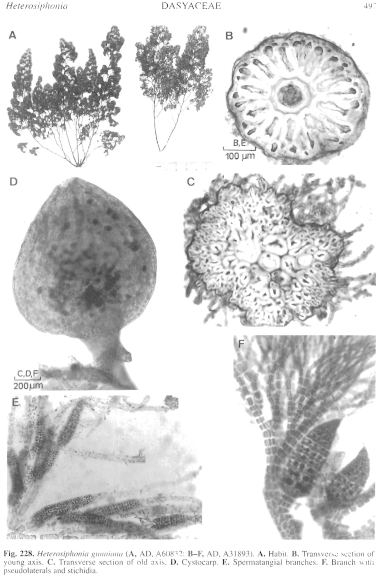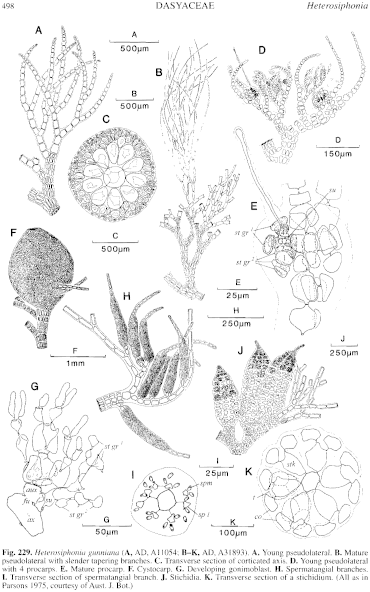|
|
|
|
|
|||||||||||
|
Electronic Flora of South Australia Species Fact Sheet
Phylum Rhodophyta – Order Ceramiales – Family Dasyaceae
Selected citations: De Toni 1903: 1231; 1924: 445. Falkenberg 1901: 651, pl. 19 figs 1, 2. Fuhrer et al. 1981: pl. 70. Huisman & Walker 1990: 428. Lucas 1912: 158; 1929a: 23; 1929b: 52. Lucas & Perrin 1947: 316, fig. 153. May 1965: 381. Mazza 1910: No. 351. Parsons 1975: 618, figs 17–19, 42. Silva et al. 1996: 442.
Synonyms
Polysiphonia gunniana Harvey 1844: 437.
Dasya gunniana (Harvey) Harvey 1847: 59, p1. 17; 1855a: 542; 1859b: 301; 1863, synop.: xxii. J. Agardh 1863: 1200; 1890a: 85. Kützing 1864: 24, pl. 80. Reinbold 1897: 57. Sonder 1853: 702; 1881: 35. Wilson 1892: 165.
Eupogonium gunnianum (Harvey) Kützing 1849: 798.
Thallus (Fig. 228A) medium to dark red-brown, erect, with one to several main axes 10–20 (–30) cm high and strongly developed lateral branches, denuded below, axes 1–1.5 (–2) mm in diameter where heavily corticated, lateral branches alternately distichous, mostly 2–10 (–50) mm apart, usually with further similar branching. Lesser branches terminating in flabellate tufts (Figs 228F, 229A, B) of rhodoplastic, ecorticate, basally polysiphonous but mostly monosiphonous, filaments to 4 mm long. Holdfast discoid, 2–15 mm across; epilithic. Structure. Apices of axes sympodial and distichous, developing 8–10 (–12) pericentral cells (Figs 228B, 229C), commencing 10–16 segments below the apical cell, produced in alternating sequence. Pseudolaterals (2–) 3–5 (–7) segments apart, each with several slender subdichotomous, tapering, upper monosiphonous filaments (Fig. 229B), lower cells 30–70 µm in diameter and L/D 1.3–3, tapering gently to upper cells 6–12 µm in diameter and L/D 8–15; the basal 5–7 segments becoming polysiphonous with 4–9 pericentral cells; segments 100–175 µm in diameter and L/D 0.8–2 (longer in deep water plants). Cortication commences well below the apices, by small cells cut off from the base of pericentral cells, developing into descending rhizoids which form a cortex 4–8 cells thick, outer cortical cells 12–25 µm in diameter, with contorted rhizoids (Fig. 228C). Lateral branches develop from lower cells of pseudolaterals. Rhodoplasts discoid, in chains in larger cells.
Reproduction: Gametophytes dioecious. Procarps (Fig. 229D, E) develop on lower segments of the pseudolaterals subtending a subdichotomy, which develop 5 pericentral cells, the fifth formed bearing a carpogonial branch and 2 sterile groups which divide to form a number of pericarp initials. Post-fertilization, the auxiliary cell, residual supporting cell, axial cell and lower gonimoblast cells form a fusion cell (Fig. 229G) below the much branched gonimoblast with terminal or short rows of ovoid carposporangia 45–65 in diameter, with later carposporangia developing from below. Cystocarps (Figs 228D, 229F) large, ovoid to subspherical, 1–1.5 mm in diameter, with little or no neck, on polysiphonous branches, often with remains of monosiphonous filaments protruding through the pericarp which is corticated with 3–4 layers of cells. Spermatangial branches (Figs 228E, 229H) occur as branches of the pseudolaterals, cylindrical with a short monosiphonous stalk and a terminal filament 6–12 cells long, 150–300 µm long and 30–50 µm in diameter, the axial cells with 5 pericentral cells (Fig. 229I) which divide to form initials each producing 4–5 spermatangia.
Tetrasporangial stichidia (Figs 228F, 229J) occur on basal polysiphonous segments of the pseudolaterals, cylindrical to lanceoid, 500–1500 µm long and 250–400 µm in diameter, terminated by a monosiphonous filament 4–8 cells long, with 14–25 fertile segments; each segment with 6 or 7 pericentral cells (Fig. 229K), all producing subspherical to slightly ovoid tetrasporangia 100–150 µm in diameter, decussately divided, each covered by the 4 cover cells.
Type from Georgetown, Tas. (Gunn); lectotype Gunn 1265 in Herb. Harvey, TCD.
Selected specimens: Eyre, W. Aust., drift (Parsons, 22.xi.1968; AD, A34408). Twin Rocks, Head of Great Australian Bight, S. Aust., 20–22 m deep (Broaden, 19.i.1991; AD, A61139). Elliston, S. Aust., 10–11 m deep in bay (Shepherd, 20.x.1969; AD, A35022). N Spencer Gulf, S. Aust., 11 m deep (Shepherd, 4.ix.1973; AD, A44109). Tiparra Reef, S. Aust., 5 m deep (Shepherd, 11.i.1978; AD, A49404). Port Turton, Yorke Pen., S. Aust., 8–10 m deep (Kald, 5.ix.1970; AD, A37262). Off Troubridge I., S. Aust., 23 m deep (Shepherd, 4.ii.1969; AD, A33832). West Beach, S. Aust., drift (Womersley, 1.xii.1946; AD, A4519). West Bay, Kangaroo I., S. Aust., drift (Womersley, 6.i.1946; AD, A3284). American R. inlet, Kangaroo I., S. Aust., 2–4 m deep near Muston (Kraft, 2.xii.1971; AD, A41142). Pennington Bay, Kangaroo I., S. Aust., in shallow pools (Parsons, 17.xi.1967; AD, A31893 -"Marine Algae of southern Australia" No. 115) and uppermost sublittoral (Womersley, 20.xii.1990; AD, A60832 -"Marine Algae of southern Australia" No. 115a). Robe, S. Aust., upper sublittoral pools (Womersley, 5.xii.1995; AD, A64771). Point Lonsdale, Vic., drift (Sinkora A1019, 14.xi.1970; AD, A62679). S of Crawfish Rock, Westernport Bay, Vic., 9 m deep (Watson, 30.xi.1968; AD, A33594). Walkerville, Vic., in large pool (Sinkora A1789, 21.xi.1973; AD, A53491). Low Head, Tas., 2–4 m deep (Perrin, Feb. 1940; AD, A9039). Bruny I. (opp. Gordon), Tas., 2–3 m deep (Brown, 10.x.1989; AD, A57831).
Distribution: Fremantle, W. Aust., to Walkerville. Vic., and around Tasmania.
Taxonomic notes: H. gunniana is a common species, from shallow to deep water, often prolific in pools and on reef edges under rough-water conditions. It is closely related to H. lawrenciana (see below) but has cortication commencing well below the apices so that most upper parts are clearly polysiphonous, and differs in transverse section appearance.
References:
AGARDH, J.G. (1863). Species Genera et Ordines Algarum. Vol. 2, Part 3, pp. 787–1291. (Gleerup: Lund.)
AGARDH, J.G. (1890a). Till algernes systematik. Acta Univ. lund. 26(3), 1–125, Plates 1–3.
DE TONI, G.B. (1903). Sylloge Algarum omnium hucusque Cognitarum. Vol. 4. Florideae. Sect. 3, pp. 775–1521 + 1523–1525. (Padua.)
DE TONI, G.B. (1924). Sylloge Algarum omnium hucusque Cognitarum. Vol. 6. Florideae. (Padua.)
FALKENBERG, P. (1901). Die Rhodomelaceen des Golfes von Neapel und der angrenzenden Meeres-abschnitte. Fauna und Flora des Golfes von Neapel. Monogr. 26. (Friedlander: Berlin.)
FUHRER, B., CHRISTIANSON, I.G., CLAYTON, M.N. & ALLENDER, B.M. (1981). Seaweeds of Australia. (Reed: Frenchs Forest, Sydney.)
HARVEY, W.H. (1844). Algae of Tasmania. Lond. J. Bot. 3, 428–454.
HARVEY, W.H. (1847). Nereis Australis, pp. 1–64, Plates 1–25. (Reeve: London.)
HARVEY, W.H. (1855a). Some account of the marine botany of the colony of Western Australia. Trans. R. Jr. Acad. 22, 525–566.
HARVEY, W.H. (1859b). Algae. In Hooker, J.D., The Botany of the Antarctic Voyage. III. Flora Tasmaniae. Vol. II, pp. 282–343, Plates 185–196. (Reeve: London.)
HARVEY, W.H. (1863). Phycologia Australica. Vol. 5, Plates 241–300, synop., pp. i-lxxiii. (Reeve: London.)
HUISMAN, J.M. & WALKER, D.I. (1990). A catalogue of the marine plants of Rottnest Island, Western Australia, with notes on their distribution and biogeography. Kingia 1, 349–459.
KÜTZING, F.T. (1849). Species Algarum. (Leipzig.)
KÜTZING, F.T. (1864). Tabulae Phycologicae. Vol. 14. (Nordhausen.)
LUCAS, A.H.S. & PERRIN, F. (1947). The Seaweeds of South Australia. Part 2. The Red Seaweeds. (Govt Printer: Adelaide.)
LUCAS, A.H.S. (1912). Supplementary list of the marine algae of Australia. Proc. Linn. Soc. N.S.W. 37, 157–171.
LUCAS, A.H.S. (1929a). The marine algae of Tasmania. Pap. Proc. R. Soc. Tasm. 1928, 6–27.
LUCAS, A.H.S. (1929b). A census of the marine algae of South Australia. Trans. R. Soc. S. Aust. 53, 45–53.
MAY, V. (1965). A census and key to the species of Rhodophyceae (red algae) recorded from Australia. Contr. N.S.W. natn. Herb. 3, 349–429.
MAZZA, A. (1910). Saggio di Algologia Oceanica. Nuova Notarisia 21, Nos. 309–368.
PARSONS, M.J. (1975). Morphology and taxonomy of the Dasyaceae and Lophothalieae (Rhodomelaceae) of the Rhodophyta. Aust. J. Bot. 23(4), 549–713.
REINBOLD, T. (1897). Die Algen der Lacepede und Guichen Bay und deren näherer Umgebung (Süd Australien), gesammelt von Dr. A. Engelhart-Kingston. Nuova Notarisia 8, 41–62.
REINBOLD, T. (1899). Meeresalgen von Investigator Street (Slid Australien), gesammelt von Miss Nellie Davey (Waltham, Honiton). Hedwigia 38, 39–51.
SILVA, P.C., BASSON, P.W. & MOE, R.L. (1996). Catalogue of the Benthic Marine Algae of the Indian Ocean. (University of California Press: Berkeley, Los Angeles & London.)
SONDER, O.W. (1853). Plantae Muellerianae. Algae. Linnaea 25, 657–709.
SONDER, O.W. (1881). In Mueller, F., Fragmenta Phytographiae Australiae. Supplementum ad volumen undecinum: Algae Australianae hactenus cognitae, pp. 1–42, 105–107. (Melbourne.)
WILSON, J.B. (1892). Catalogue of algae collected at or near Port Phillip Heads and Western Port. Proc. R. Soc. Vict. 4, 157–190.
The Marine Benthic Flora of Southern Australia Part IIIC complete list of references.
Publication:
Womersley, H.B.S. (24 December, 1998)
The Marine Benthic Flora of Southern Australia
Rhodophyta. Part IIIC. Ceramiales – Ceramiaceae, Dasyaceae
©State Herbarium of South Australia, Government of South Australia
Illustrations in Womersley Part IIIA, 1998: FIGS 228, 229.

Figure 228 enlarge
Fig. 228. Heterosiphonia gunniana (A, AD, A60832; B–F, AD, A31893). A. Habit. B. Transverse section of young axis. C. Transverse section of old axis. D. Cystocarp. E. Spermatangial branches. F. Branch with pseudolaterals and stichidia.

Figure 229 enlarge
Fig. 229. Heterosiphonia gunniana (A, AD, A11054; B–K, AD, A31893). A. Young pseudolateral. B. Mature pseudolateral with slender tapering branches. C. Transverse section of corticated axis. D. Young pseudolateral with 4 procarps. E. Mature procarp. F. Cystocarp. G. Developing gonimoblast. H. Spermatangial branches. I. Transverse section of spermatangial branch. J. Stichidia. K. Transverse section of a stichidium. (All as in Parsons 1975, courtesy of Aust. J. Bot.)

|
Email Contact: State Herbarium of South Australia |

|